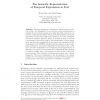Free Online Productivity Tools
i2Speak
i2Symbol
i2OCR
iTex2Img
iWeb2Print
iWeb2Shot
i2Type
iPdf2Split
iPdf2Merge
i2Bopomofo
i2Arabic
i2Style
i2Image
i2PDF
iLatex2Rtf
Sci2ools
AUSAI
2007
Springer
2007
Springer
The Semantic Representation of Temporal Expressions in Text
Abstract. Temporal expressions—references to points in time or periods of time—are widespread in text, and their proper interpretation is essential for any natural language processing task that requires the extraction of temporal information. Work on the interpretation of temporal expressions in text has generally been pursued in one of two paradigms: the formal semantics approach, where an attempt is made to provide a well-grounded theoretical basis for the interpretation of these expressions, and the more pragmatically-focused approach represented by the development of the TIMEX2 standard, with its origins in work in information extraction. The former emphasises formal elegance and consistency; the latter emphasises broad coverage for practical applications. In this paper, we report on the development of a framework that attempts to integrate insights from both perspectives, with the aim of achieving broad coverage of the domain in a well-grounded manner from a formal perspective...
Artificial Intelligence | AUSAI 2007 | Broad Coverage | Temporal Expressions | Well-grounded Theoretical Basis |
| Added | 07 Jun 2010 |
| Updated | 07 Jun 2010 |
| Type | Conference |
| Year | 2007 |
| Where | AUSAI |
| Authors | Robert Dale, Pawel P. Mazur |
Comments (0)

